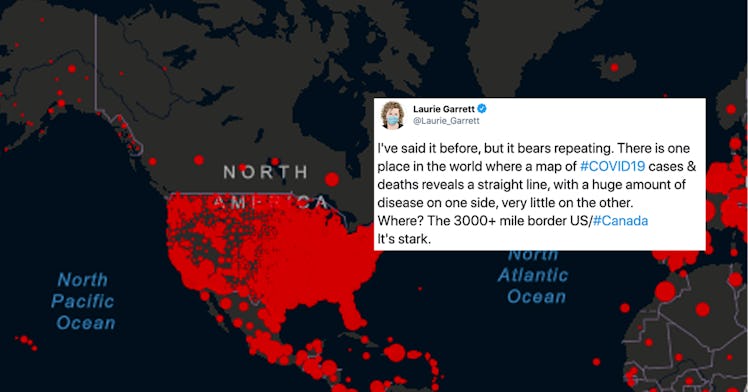Map Shows How Canada’s Response to COVID Really Is Superior
There is a striking difference between coronavirus cases in the U.S. and Canada.

The 3,000+ border between the United States and
Canada marks the dividing line between the two countries. These days, it also marks an astoundingly severe difference between the countries’ handling of the coronavirus pandemic,data fromA visualization of the difference between how COVID-19 spread in the United States and how it has spread in Canada is simple, stark, and horrifying, especially for Americans. The mapshared on Twitter on October 28 — the day that the United States reported 99,321 cases in a day, the highest record of any country in the world.It paints a striking portrait of what COVID-19 looks like in two border countries. The data visualization has the U.S. painted in thick strokes of red to signal the unmanaged outbreak we’re seeing in most of the entire country, whereas Canada — which is currently dealing with far fewer daily cases — shows significantly smaller smatterings of red, and thus far fewer clusters of coronavirus outbreak.
Garrett writes, “There is one place in the world where a map of #COVID19 cases & deaths reveals a straight line, with a huge amount of disease on one side, very little on the other. Where? The 3000+ mile border US/#Canada.” Garrett adds, “In #Canada, there have cumulatively been 228,079 cases and 10,082 deaths. In the USA we’ve reached a dismal 8.9 million cases with 227,663 deaths. Canada’s total caseload is about = to our death toll. Is it not long overdue for America to ask, “What is Canada doing right?” Apparently, quite a bit. On November 1, the United States reported 74,236 new COVID-19 cases. By comparison, Canada reported 2,330 new cases that same day. And things are only trending worse in the United States, with dozens of thousands of cases confirmed daily. The map does a good job of illustrating how two countries so close together can contrast so sharply in terms of their handling of the pandemic — and how people south of the Canadian border have suffered as a result.